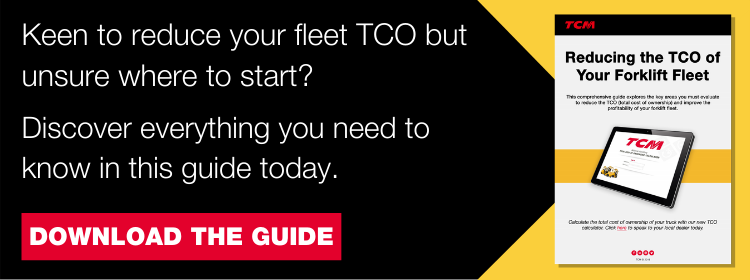Share Article

With so many different battery types on the market, it can be difficult knowing whether you’re using the most cost-efficient option. Discover how to boost fuel efficiency and reduce the TCO of your fleet.
In 2018, reducing carbon emissions while maintaining fuel efficiency remains a major issue for many businesses worldwide. It has become even more of a concern since the government announced to ban on the sale of all new petrol and diesel vehicles by 2030.
Fortunately, the majority of forklift trucks—except those required for heavy-duty outdoor use—are already using rechargeable battery technologies. That said, with the subsequently increased requirement for charging stations, how can we ensure energy costs are kept to a minimum? The answer is this: by choosing the correct battery technology.
Choosing an electric forklift truck over diesel or LPG will immediately reduce your carbon emissions. Battery-operated forklifts produce zero emissions, making them particularly suitable for daily warehouse use and large-scale operations.
Currently, there are three different types of battery technology on the market:
- Lead-acid
- Nickel Cadmium (NiCd)
- Lithium-ion (Li-ion)
Choosing the right forklift battery to increase fuel efficiency and keep material handling costs down is dependent on several interlocking factors. Read on to discover which is best suited to your operation and business objectives.
Lead-acid batteries: the economical option
Lead-acid batteries are by far the most economic and recyclable power source. It is believed that these will continue to be the batteries of choice for counterbalance and reach trucks for years to come.
One area with stark comparisons is battery life over time. If a lead-acid battery has been maintained and charged correctly, you can expect an average lifespan of 1,500 cycles. A NiCd (Nickel Cadmium) battery under the same circumstances will last for approximately 8,000 cycles. A lithium-ion battery greatly surpasses this, delivering over 10,000 cycles during its lifespan. Despite being the most economical, lead-acid batteries’ comparatively low battery life is certainly worth bearing in mind if considering the switch.
There are also comparisons to make when it comes to battery degradation. Lithium-ion batteries don’t degrade at all, whereas NiCd batteries offer between 0-2% degradation, and lead-acid batteries can degrade by as much as 32% during the course of their lifetime.
Need to know: Although lead-acid batteries typically degrade more and can’t achieve as many cycles as their NiCd and lithium-ion counterparts, they are far less costly to run. In fact, lead-acid batteries are up to four times less expensive than NiCd batteries, and up to seven times less expensive than lithium-ion batteries. This is a striking difference which has the potential to dramatically reduce fleet management costs.
Nickel Cadmium (NiCd) batteries: the reliable option
Comparatively, NiCd batteries can offer roughly 90% of the advantages of lithium-ion batteries—at a fraction of the cost. For fueling heavy lifting machinery such as forklift trucks, NiCd batteries are often considered a reliable middle-of-the-road option.
Industrial NiCd batteries are considerably larger than other battery types. Each cell consists of free-flowing liquid electrolytes, which is especially useful for applications demanding high discharge rates. NiCd batteries are able to perform under these conditions without becoming damaged or losing capacity, making them a durable, reliable solution.
Despite the benefits of NiCd batteries, they are significantly more costly than lead-acid and have a considerably lower energy capacity than lithium-ion batteries. It’s also worth noting that NiCd batteries are reasonably toxic and heavy, and demand greater care—both in their use and recycling.
Need to know: For businesses most concerned with lowering costs and improving fuel efficiency, NiCd batteries are unlikely to fit the bill. However, for material handling operations that are particularly intensive, NiCd batteries make for a highly durable and reliable option.
Lithium-ion batteries: the pollution-free option
There is still much work to be done before lithium-ion batteries become a viable option for the material handling industry based on their steep price point. Despite the cost, they offer several clear benefits:
- They’re completely maintenance free
- They require no filling
- They’re gas free
- They don't pollute the atmosphere
Although lithium-ion batteries have a considerably lower capacity than lead-acid, they can be ‘opportunity charged’—making them the perfect solution for businesses operating 24/7 who can’t afford extended downtime.
Need to know: As lithium-ion batteries recharge much faster than alternative commercial options, it’s likely that you will only ever need one battery per machine (instead of two to three lead-acid batteries per forklift) to maintain operations.
Whether it’s the environmental benefits of lithium-ion batteries, the reliability of NiCds, or the cost-effectiveness of lead-acid that piques your interest, assessing your business’ unique needs should be an integral aspect of the decision-making process.
Keen to see how Lithium-ION can help power your operations? Read more here.
Electrification paves way for fuel efficiency and the future of material handling
For optimum fuel efficiency and lower emissions, battery-operated forklifts are certainly the way forward in the material handling industry. However, before making the switch, ensure that you evaluate the best battery type for your operation and relevant supporting battery technology to suit your business needs.
Taking the time needed to make the right decision will not only save you money in the long run but keep you on track for when the new government regulation on petrol and diesel engines comes into play in 2030.

.png?width=50)


